HP Stream 11 Review: A New Take On Low Cost Computing
by Brett Howse on December 17, 2014 8:00 AM ESTDisplay
The rise of smartphones and tablets has dramatically changed the display landscape, with practically all tablets having In Plane Switching (IPS) displays. IPS offers much better viewing angles and color reproduction compared to the standard laptop displays that use a Twisted Nematic (TN) based LCD. There has been the start of a push to IPS panels on notebooks, but far too many are still burdened with TN. The lower the cost of the device, the higher the probability it will have a TN panel - Chromebooks included. The HP Stream is one of the lowest priced notebooks available and as such, it is saddled with a TN LCD, and not a very good one at that. But, with the price point it has achieved, we must set our sights a bit lower.
With a resolution of 1366x768, the HP Stream 11 has the standard “HD” resolution and 16:9 aspect ratio of almost all notebooks under $500, and once again with this price we should not be shocked or outraged. Compromises must happen to reach lower prices, and the display is almost always one of the first to go. With the 11.6” diagonal dimension, this display comes in at 135 pixels per inch, which is actually higher than the standard 96 DPI Windows was founded on. It is not high DPI by any means, but it is what is expected at this price point.
With a fairly low resolution, there is no need for any sort of strange pixel arrangement, and as such we have a standard RGB stripe. The display has a matte finish, which causes some subpixel distortion.
To evaluate our displays, we utilize a custom workflow in SpectraCal’s CalMAN 5 software. To measure brightness and black levels, an i1Display Pro from X-Rite is used, and for color testing the X-Rite i1Pro spectrophotometer is leveraged.
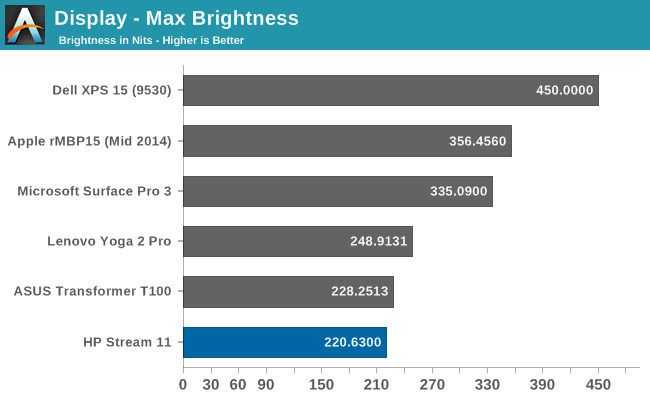
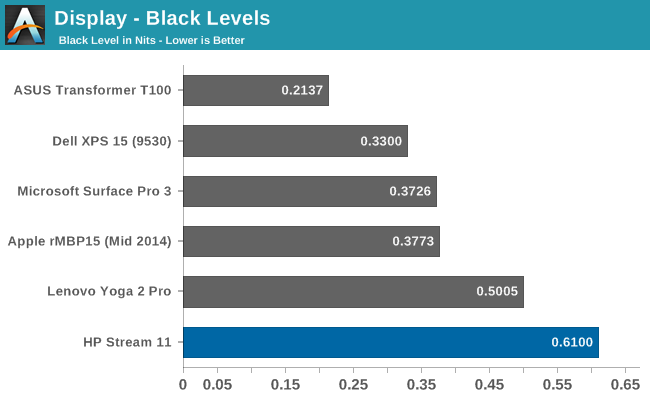
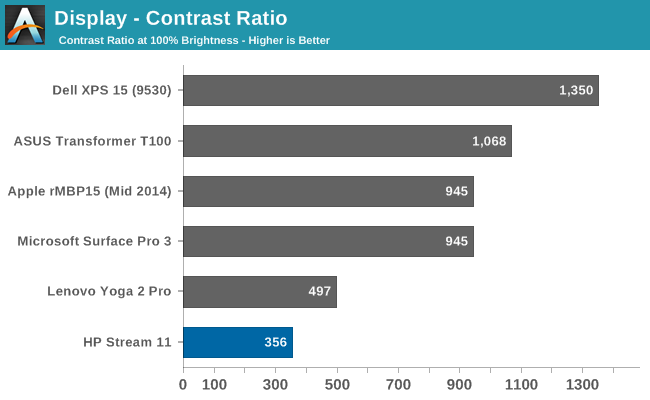
The HP Stream 11 is not a very bright display, but at 220 nits it is fine for indoor use. The matte finish would help somewhat for outdoor viewing, but would still make for a poor experience. High black levels result in a very poor 356:1 contrast ratio, which is further hampered by the poor viewing angles of the TN TFT.

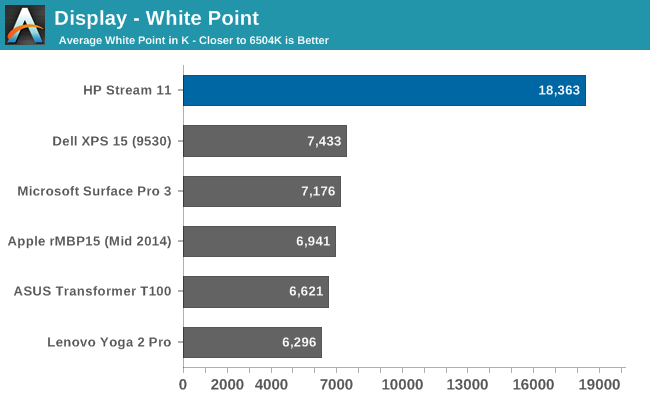
As you can see in the image, the blues in this display are ridiculously high, and the reds drop to nothing. This gives an absurd uncalibrated white point of 18363, when it should be as close to 6504 as possible. The grayscale accuracy is also far too high at 11.6.
When we perform our testing, we are targeting sRGB which is the standard color space for most web content. The HP Stream is not even close to the entire sRGB space, and the amount of drift on our saturation sweeps is very severe. The 100% blue and 100% red are both closer to the 80% mark than the 80% is, which makes the magenta very shifted and compressed. The overall score of 12.01 is very poor.
The colorchecker only confirms the bad news, with an overall score of 10.5. This panel is really poor. Not much more can be said. Calibration also did nothing for the display. It is difficult to calibrate a display to a particular color space when it cannot do the entire gamut. To have a standard, we calibrate to sRGB at 200 nits, and while the Stream 11 is bright enough for this, the LEDs are at practically maximum brightness which likely makes these results even worse.
We have been spoiled by an influx of high quality displays on devices lately. The HP Stream 11 does not continue this trend. It has a TN LCD which is quite terrible, and harkens back to the days of old. At the same time, some leeway should be given due to the price point of the laptop. Clearly HP had a $199 price point in mind and had to find savings to hit that price, and the LCD is always one of the first things on the chopping block. Still, this is even a poor display by poor display standards.







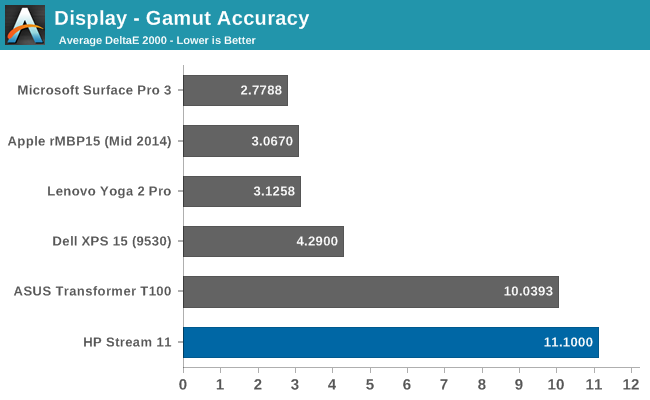








59 Comments
View All Comments
hojnikb - Wednesday, December 17, 2014 - link
Are you guys gonna review the Eeebook X205, which is another lowcost laptop, but uses baytrail-t with 4 cores..asgallant - Wednesday, December 17, 2014 - link
You mean this review? http://www.anandtech.com/show/8478/asus-eeebook-x2...asgallant - Wednesday, December 17, 2014 - link
Crap, nevermind, saw the link without reading it.Dakosta Le'Marko - Thursday, December 18, 2014 - link
Stunning! I've started averaging 85 dollars/hourly since i started working online half a year ago... What i do is to sit at home several hours each day and do simple jobs i get from this company that i found over the internet... I am very happy to share this with you... It's an awesome side job to have http://orkan201.tkcoder543 - Saturday, December 20, 2014 - link
Really though. The X205TA is far more exciting to me: fanless, 50% more battery life, super thin and light, and generally lower cost on Amazon. The performance difference shouldn't be significant -- if you're looking for performance in this category, you're looking in the wrong category.Shadowmaster625 - Wednesday, December 17, 2014 - link
What sort of league of legends testing did you do? Did you try a 5v5 teamfight or just solo laning?jabber - Wednesday, December 17, 2014 - link
Cue forward to this time next year as everyone that bought one moans bitterly they have to pay an extra $100 a year to run it.Not as cheap as some may think.
hawler - Wednesday, December 17, 2014 - link
Did I miss something? What do they have to pay for to run it?WithoutWeakness - Wednesday, December 17, 2014 - link
He's saying that people will see "$200 laptop with Office included" and assume that's the whole price. The reality of the situation is that Office 365 Personal Edition is $70/year and Home Edition is $100/year. With only 17.5GB free to the user out of the box most users will start using their free OneDrive storage for documents and such.What they may not realize is that they're expected to pay $70-100/year to use Office and that cloud storage and if they don't pay then they will lose the ability to work on documents and access their online files. The only saving grace is that OneDrive offers 15GB of free storage so if you're under 15GB and don't need Office then no biggie.
What it comes down to is that there will be people complaining a year from now that they bought a $200 laptop and now they're being asked to shell out another $70 to use Office (that was installed for free when they bought the laptop) and access their documents that they stored in the cloud. You don't get that with a Chromebook.
Drumsticks - Wednesday, December 17, 2014 - link
What lol?If you think Microsoft will out windows under a subscription, I highly doubt you're right.
IF that's right though, by some strange business decision of Microsoft, the idea that currently available computers that have been purchased already will need to pay is hilarious.